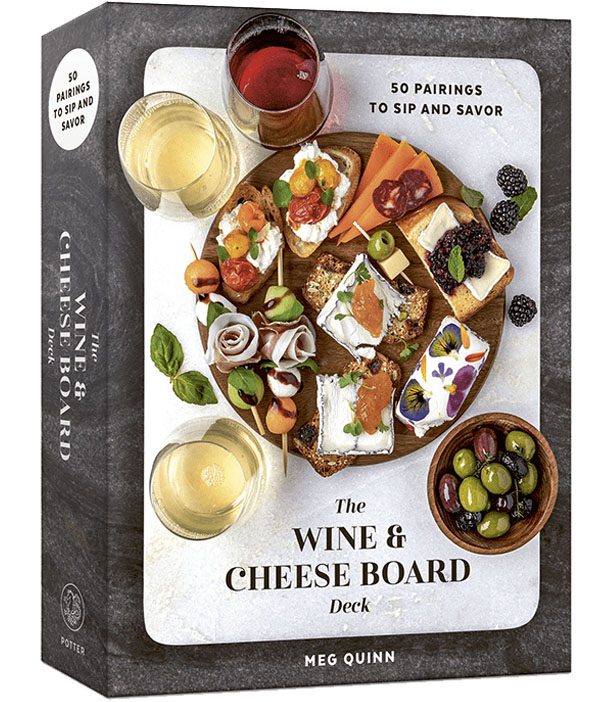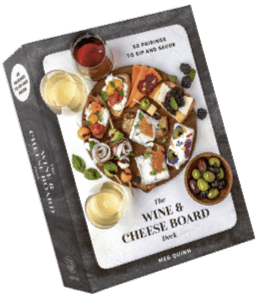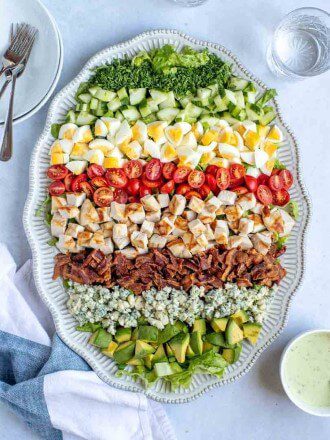This post contains collections of products that I personally recommend (it may contain affiliate links).

I love pairing wine and cheese, especially when I’m serving a charcuterie board! But really, there’s a wine pairing for almost anything! Below, I share easy-to-understand tips about different types of wine, and then how to pair wine with cheese and other types of food.

What’s The Difference Between Red & White Wine
For the most part, red wine is made from grapes with red skins, while white wine is made from grapes with green or white skins. (There are few exceptions like the white blanc de noirs Champagne, which is made with red grapes.)
Wine gets its color from the amount of time that juice from the crushed grapes are left to ferment in contact with the skins. While the juice for most white wines are drained quickly, leaving a clear, or “white” wine, it’s the skin contact that adds color and tannins (more on these below!).
Fun fact: rosé wines are made by draining juice from crushed red grapes after a shorter amount of time.

Wine Styles
In The Wine & Cheese Board Deck, I dig into specific pairings to make at home, but I also share some important pairing info, like this wine guide in the deck:
Light Red Wines
Leaner in body, lower in alcohol and tannins. Popular examples: pinot noir, Beaujolais
Medium Red Wines
Average in alcohol (usually under 14 percent) and weight. Popular examples: Chianti, rioja, merlot
Big Red Wines
Rich, full bodied, with high tannins and high alcohol, sometimes less acidic from oak aging. Popular examples: cabernet sauvignon, malbec, Shiraz, Syrah
Rosé Wines
High acidity, light to dark pink, with a berry, fruity flavor.
Light White Wines
Crisp, lean, with lower alcohol. Popular examples: muscadet, pinot grigio, riesling
Medium White Wines
Moderate in alcohol and body, ranging from aromatic to fruity, to more savory in flavor. Popular examples: sauvignon blanc, Grüner Veltliner, pinot gris, chenin blanc
Big White Wines
Rich, viscous, and smooth full-bodied wines, often with oak-aging. Popular examples: Viognier, chardonnay
Sparkling Wines
Refreshing, bright, and bubbly. Popular examples: Champagne, prosecco, cava
Sweet Wines
Has residual sugar, often viscous, tastes sweet. Popular examples: Moscato d’Asti, some rieslings
Orange Wines
Often more tannic and full bodied than white wine, usually with some oxidation,
For the full rundown on how to pair cheese and wine with 50 perfect pairings, grab a copy of The Wine & Cheese Board Deck – perfect for gifting too!

What Are Tannins
Tannins are what makes a wine dry. They come from fermenting the grape juice with the skins, seeds, stems, and even the wood barrels used during aging. It’s possible for white wines to have tannins, but all reds have tannins just because of the way they are made. If you didn’t know, white wine is made mostly from the juice that is pressed from the grapes, whereas reds are fermented with the skin (which is what makes it red!).
In general, wines that are more tannic will pair better with hard and aged cheeses, while wines that are less tannic work with softer and more fresh cheeses.
According to Wine Enthusiast, “Some grape varieties have more tannins than others. Examples that can make really tannic wines include Cabernet Sauvignon, Nebbiolo, Mourvèdre, Malbec, Tannat, Syrah/Shiraz, Tempranillo, Merlot and Sangiovese. Whether the winemaking technique encourages the extraction of the tannins is a question of style. Wines made from grapes like Pinot Noir, Gamay and Grenache, which have much thinner grape skins, are much less tannic.”

How To Read a Wine Label
There’s no perfect science to reading wine labels unfortunately. Like most things, the more you read and then drink, the easier it will get to choose! However, there are few things you should always be able to find on a wine label:
- The wine producer’s name: this won’t tell you very much unless you have a specific producer in mind. Still great to keep track of!
- The grape variety and/or region: This is probably the biggest hint about what the wine should taste like. A lot of European wines only list the region given that there are certain grapes producers are allowed to use to put said region on the label. For example: Red Bordeaux can be made from Cabernet Sauvignon, Merlot, and Cab Franc and a handful of other grapes. (Check out this super helpful global guide!)
- The vintage (aka the year the grapes were harvested): The vintage is important if you plan to look up weather conditions for that region during the specified year to see how the wine’s flavor may be affected–or if you’re a collector! But a lot of the time, the year doesn’t have a lot of bearing and it’s the least important thing on the label for my wine enjoyment purposes!
When in doubt, always ask someone in the store! They can usually guide you to what you’re looking for.

How To Pair Wine
When it comes to pairing wine with cheese, I focus on these three things – contrasting, complementary, and regions:
- Contrasting means the wine and cheese have opposite characteristics, like how acidic wines cut through rich, creamy cheeses.
- Complementary means the wine and cheese have similar characteristics, like an earthy wine with a bloomy cheese.
- Regional means the wine and cheese hail from the same area, which sometimes makes for a great pair (but not always!).
But you know me – I rarely serve just cheese! When you’re serving a board with produce, accoutrements, and other treats, there are a few things to know beyond Contrasting, Complementary, and Regional:
- Color: When it comes to fruits, try to match the color of the produce with the wine. For example, dark red wine with dark berries or crisp white wine for green grapes.
- Bridge the gap: When you have a wine on hand that isn’t quite a perfect match for your cheese, add a secondary flavor to help bring the flavors together. Think cranberries on goat cheese!
- Wine killers: There are some things that are trickier to pair well with any wine. So, if you’re presenting a paired selection, avoid: hot sauce, artichokes, chili peppers, asparagus, and vinegar.

Recommended Pairings
If you want even more specific food and wine pairing ideas, try some of these on for size:
- Fondue with Pinot Gris
- Rioja with Tapas
- Fruit with Moscato
- Steak with Cabernet Sauvignon
- Pasta & Red Sauce with Chianti
- Caesar Salad with Sauvignon Blanc
- Baked Brie with Pinot Noir
- Oysters with Champagne
Plus tons more in The Wine & Cheese Board Deck like these:

What Temperature Should Wine Be Served At?
Generally speaking, reds should be served at room temperature and whites, rosé, and sparkling wines should be chilled. The biggest exception to this rule, however, is lambrusco–it’s a sparkling red that should be kept chilled at about 45-50°F.
More specifically (according to Wine Enthusiast):
- Port: 60°F–65
- Most reds: 55°F–65°F.
- Fuller-bodied white wines (like chardonnay): 50°F -60°F
- Lighter, fruitier wines (like pinot grigio): 45°F – 50°F
- Sparkling wines: 40°F – 50°F
How to Store Wine
For unopened bottles of wine, store them in a cool, dark place (aka away from the sun) on their sides so the cork doesn’t dry out. However, sparkling wine should be kept upright because if the cork gets too moist, too much oxygen will get in and make your wine a whole lot less sparkly. Depending on the wine, unopened bottles will keep for about 1 – 5 years.
Once you open a bottle, the best solution is to drink it all so it doesn’t oxidize. However, as long as you reseal the bottles, the wine will usually last 3-5 days before it goes bad. Sparkling wines will of course go “bad” faster–or at least lose all their carbonation. That said, you can get a special wine stopper specifically for sparkling wine that will hopefully help lengthen the life of your bottle.

Show Me Your Wine and Cheese Pairings
I hope this post inspires you to pair wine with your cheese, charcuterie boards and more. Nothing makes me happier than seeing the spreads you create from my tips. If you make something inspired by this post, please tag me at @ainttooproudtomeg so I can see and share!
And, If you liked this recipe, please rate and review.
Photos by Haley Hunt Davis of Salt Worth Creative. Food styling with Ryan Norton.



















